I first discovered Korean tomato syrup during a summer visit to a Seoul café. The sweet, tangy syrup stirred into iced coffee left a lasting impression. Now, I make it every year with ripe cherry tomatoes simple, fragrant, and full of warmth.
This 2-ingredient cheong (Korean fruit syrup) is a refreshing way to enjoy tomatoes beyond savory dishes.
Why You’ll Love This Korean Tomato Syrup:
- Just 2 ingredients: ripe tomatoes and sugar
- No cooking required just time and patience
- Naturally sweet and full of fresh tomato flavor
- Perfect in coffee, cocktails, or over toast
- Keeps for 2–3 weeks in the fridge
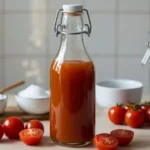
Korean Tomato Syrup Recipe
- Total Time: 2–3 days (fermentation period)
- Yield: About 1¼ cups syrup 1x
- Diet: Vegan
Description
This Korean tomato syrup, or tomato cheong, is a simple, no-cook syrup made by layering ripe cherry tomatoes with sugar and letting it naturally ferment. It’s sweet, slightly tangy, and full of rich tomato flavor perfect for stirring into iced coffee, drizzling over toast, or adding to cocktails. With only two ingredients and no cooking required, it’s a wonderfully easy way to preserve tomatoes in their sweetest form.
Ingredients
- 2 cups ripe cherry tomatoes (halved or quartered, depending on size)
- 2 cups white sugar (or substitute with raw or brown sugar for more depth)
- Optional: 1 tablespoon lemon juice (for brightness)
- Optional: A few fresh basil leaves (for aroma)
- Serving Suggestion: 1 cup cold brewed coffee
Instructions
- Wash and thoroughly dry the tomatoes. Slice the tomatoes in half or into quarters, depending on how large they are.
- In a clean, sterilized glass jar, layer tomatoes and sugar: add a layer of tomatoes, then a layer of sugar. Repeat until all ingredients are used.
- Optionally, add lemon juice or basil leaves between layers for extra flavor.
- Loosely cover the jar (not airtight) and leave it at room temperature for 2–3 days.
- Stir the mixture once daily using a clean, dry spoon.
- When the sugar has fully dissolved and the juice has thickened, strain the syrup through cheesecloth or a fine mesh sieve.
- Pour the finished syrup into a clean glass bottle and refrigerate.
- Serve chilled in drinks or over toast. Enjoy!
Notes
- The leftover tomato solids can be saved and spread on toast like a jam.
- To reduce fermentation risk, use sterilized tools and keep the environment clean.
- For a floral twist, substitute ¼ cup of sugar with honey.
- The syrup can be frozen in small portions to extend shelf life up to 3 months.
- If using basil, remove the leaves before bottling to avoid bitterness.
- Prep Time: 10 minutes
- Cook Time: 0 minutes (no-cook recipe)
- Category: Desserts & Sweets
- Method: No-cook fermentation
- Cuisine: Korean
Nutrition
- Serving Size: 1 tablespoon
- Calories: 45 kcal
- Sugar: 11 g
- Sodium: 0 mg
- Fat: 0 g
- Saturated Fat: 0 g
- Unsaturated Fat: 0 g
- Trans Fat: 0 g
- Carbohydrates: 11 g
- Fiber: 0 g
- Protein: 0 g
- Cholesterol: 0 mg
What Is Korean Tomato Syrup (Cheong)?
In Korean cuisine, cheong refers to a syrup made by preserving fruits in sugar. Unlike cooked jams, cheong is uncooked and slowly ferments at room temperature, allowing the natural juices to draw out over time. This process creates a deeply flavored, shelf-stable syrup without boiling.
Tomato cheong is a modern twist on the traditional method. While not a common ingredient in old-school Korean kitchens, it has gained popularity in cafés and among home cooks for its sweet-tart complexity. The syrup pairs especially well with cold brew, sparkling water, and even yogurt or toast.
Because tomatoes are technically fruits, their natural sugars and acidity make them perfect for this syrup-making technique.
Ingredients for Korean Tomato Syrup & Tools You’ll Need
This syrup requires just a few ingredients and basic tools no special equipment or cooking involved.
Ingredients for Korean Tomato Syrup:
- 2 cups ripe cherry tomatoes
(or any small, sweet tomatoes look for deep red and slightly soft) - 2 cups white sugar
(raw or brown sugar adds depth, but white gives a cleaner taste) - Optional:
- 1 tablespoon lemon juice (adds brightness)
- A few basil leaves (for herbal aroma)
- 1 cup cold brewed coffee (optional serving pairing)
Tools:
- Clean glass jar with a lid (preferably sterilized)
- Sharp knife for halving tomatoes
- Clean spoon for stirring daily
- Fine mesh strainer or cheesecloth
- Glass bottle or jar for storing the syrup
Pro Tip: If your tomatoes are extra juicy, give them a light mash to jumpstart the fermentation.
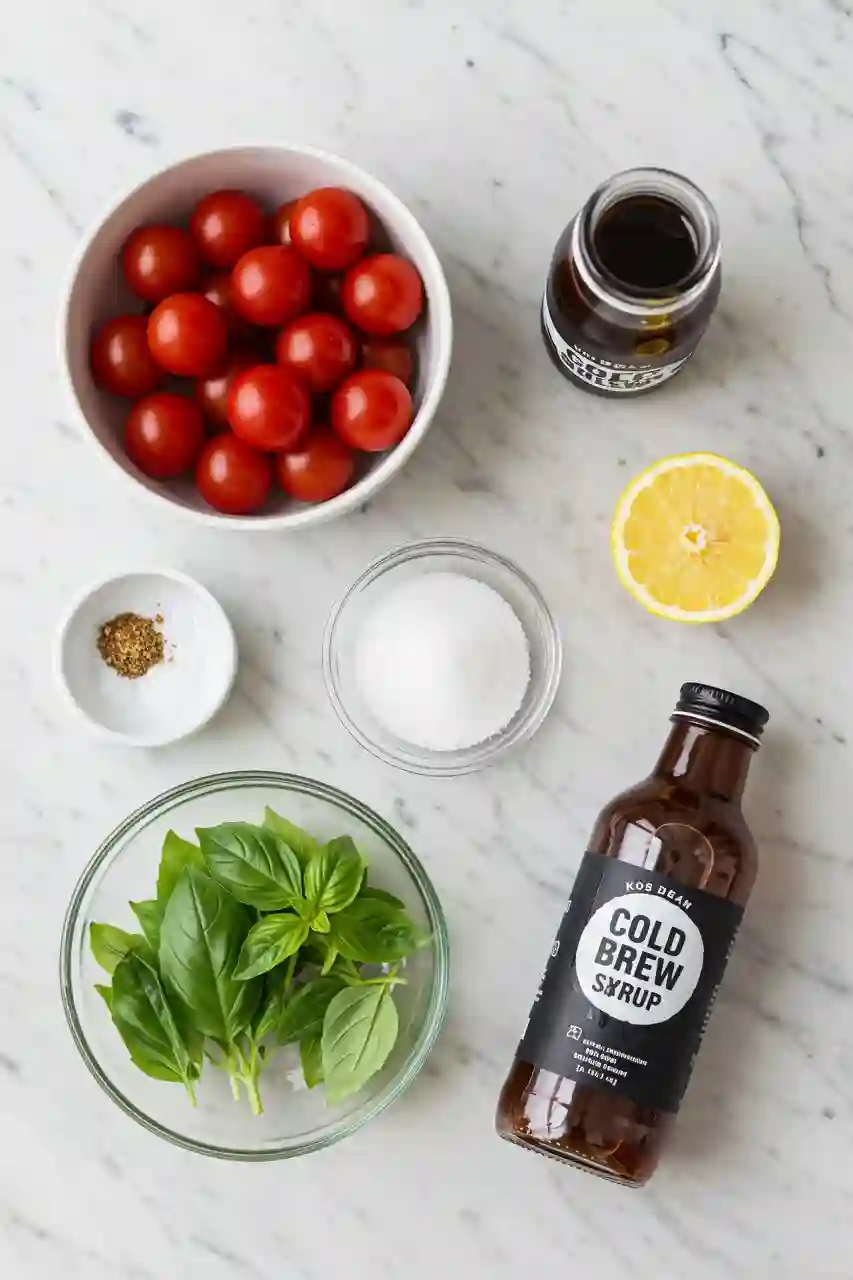
Step-by-Step to Korean Tomato Syrup Recipe
This no-cook syrup relies on slow fermentation. The key is layering and patience. Here’s how I do it best:
1. Prep the Tomatoes
Wash your tomatoes thoroughly and pat them dry. Cut each one in half (or quarters if large). Optionally, give them a light mash to release more juice.
2. Layer with Sugar
In a clean glass jar, alternate layers of tomato and sugar. Start with tomatoes, then sprinkle sugar on top. Repeat until everything is used.
Important: Do not mix or seal airtight. The sugar will naturally draw out the tomato juice.
3. Let It Sit
Loosely cover the jar (a lid resting on top is fine). Leave it at room temperature for 2–3 days. Use a sanitized spoon to gently stir the mixture once daily during fermentation. You’ll notice the sugar dissolving and the juice thickening.
Watch for bubbles light fermentation is normal, but strong sour smells mean spoilage.
4. Strain & Store
When the sugar dissolves completely and the mixture thickens, pour it through a fine strainer or cheesecloth to separate the syrup.
Discard the solids (or save them for toast). Transfer the syrup to a clean bottle and refrigerate.
Refrigerated properly, the finished syrup stays fresh for up to three weeks.
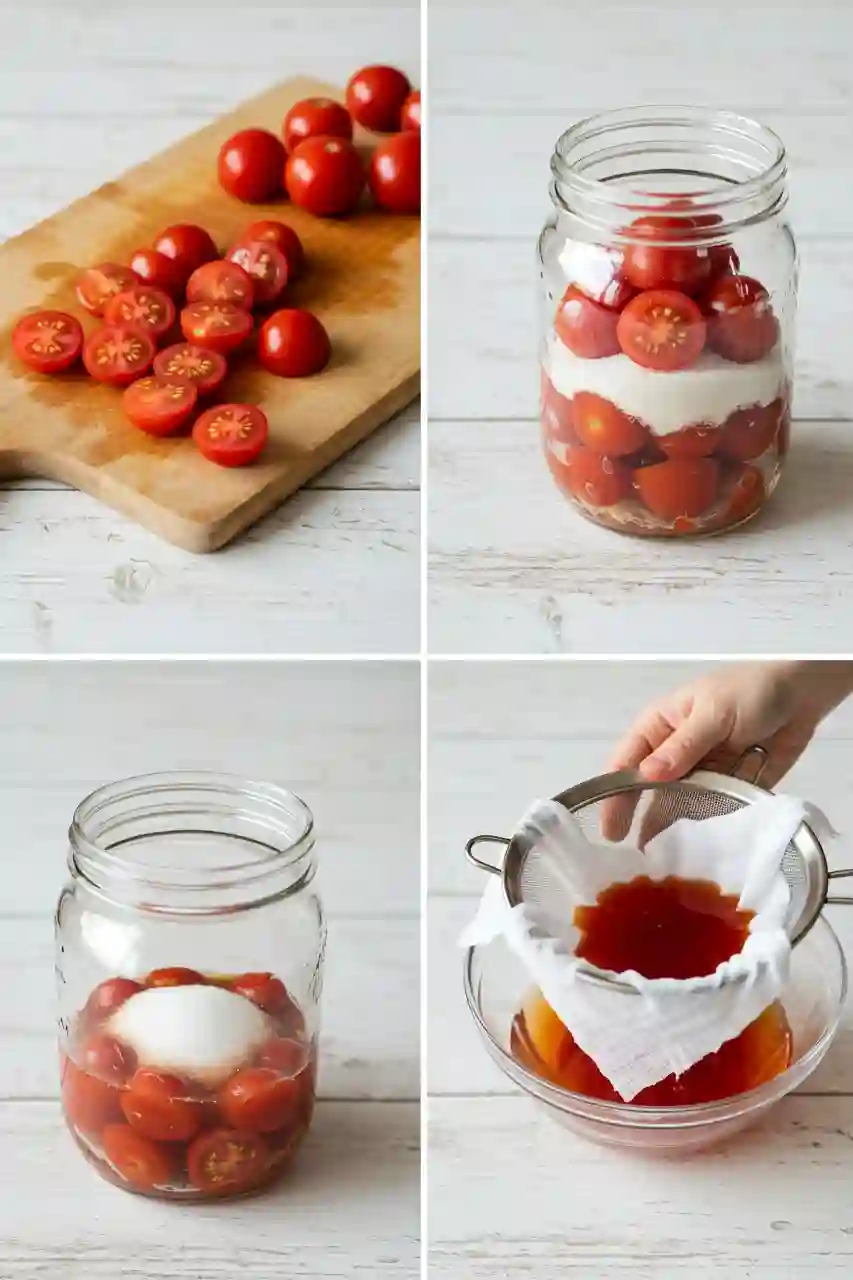
Creative Uses for Korean Tomato Syrup
Once strained, this syrup becomes a sweet, tangy base for both drinks and dishes. What makes this syrup stand out is how easily it adapts to sweet or savory recipes.
Ways to Use Tomato Cheong:
- Stir into iced coffee or cold brew for a café-style drink with subtle tomato sweetness
- Mix with sparkling water or tonic for a refreshing soda alternative
- Drizzle over yogurt, ricotta toast, or vanilla ice cream for a surprising flavor twist
- Use as a glaze for roasted vegetables or seared meats (especially pork or chicken)
- Shake into cocktails pairs beautifully with gin, vodka, or mezcal
Bonus Tip:
Save the syrup-soaked tomato solids and use them as a quick tomato jam on toast or crackers.
Variations: Basil, Lemon, Honey
This syrup is flexible. A few small tweaks can completely change its aroma and depth, without complicating the process.
Add Basil
Layer a few fresh basil leaves between tomato and sugar. It adds an herbal note that works beautifully in soda or coffee drinks.
Tip: Use whole leaves so they’re easy to remove before straining.
Add Lemon Juice
Stir in 1 tablespoon of fresh lemon juice before refrigerating the finished syrup. It brightens the flavor and balances sweetness.
Bonus: The acidity helps preserve the syrup slightly longer.
Add Honey
Replace 1/4 cup of the sugar with runny honey for floral complexity. This gives the syrup a smoother finish and a deeper golden color.
Make sure to mix gently during the layering process so the honey distributes evenly.
Tomato Cheong vs Tomato Kimchi
Though they both feature tomatoes, tomato cheong and tomato kimchi couldn’t be more different.
Tomato cheong is a sweet fermented syrup, made by preserving tomatoes in sugar. It draws on Korea’s long tradition of fruit-based cheong, which includes ingredients like green plums, yuja, or strawberries. There’s no spice, no brine, and no pungency just bright, naturally sweet tomato flavor.
Tomato kimchi, on the other hand, is a savory side dish. It often includes garlic, chili flakes, fish sauce, and fermentation. The tomatoes are typically salted and mixed with aromatics to develop depth and umami.
If you’re looking for a sweet syrup for drinks or desserts, tomato cheong is what you want not tomato kimchi.
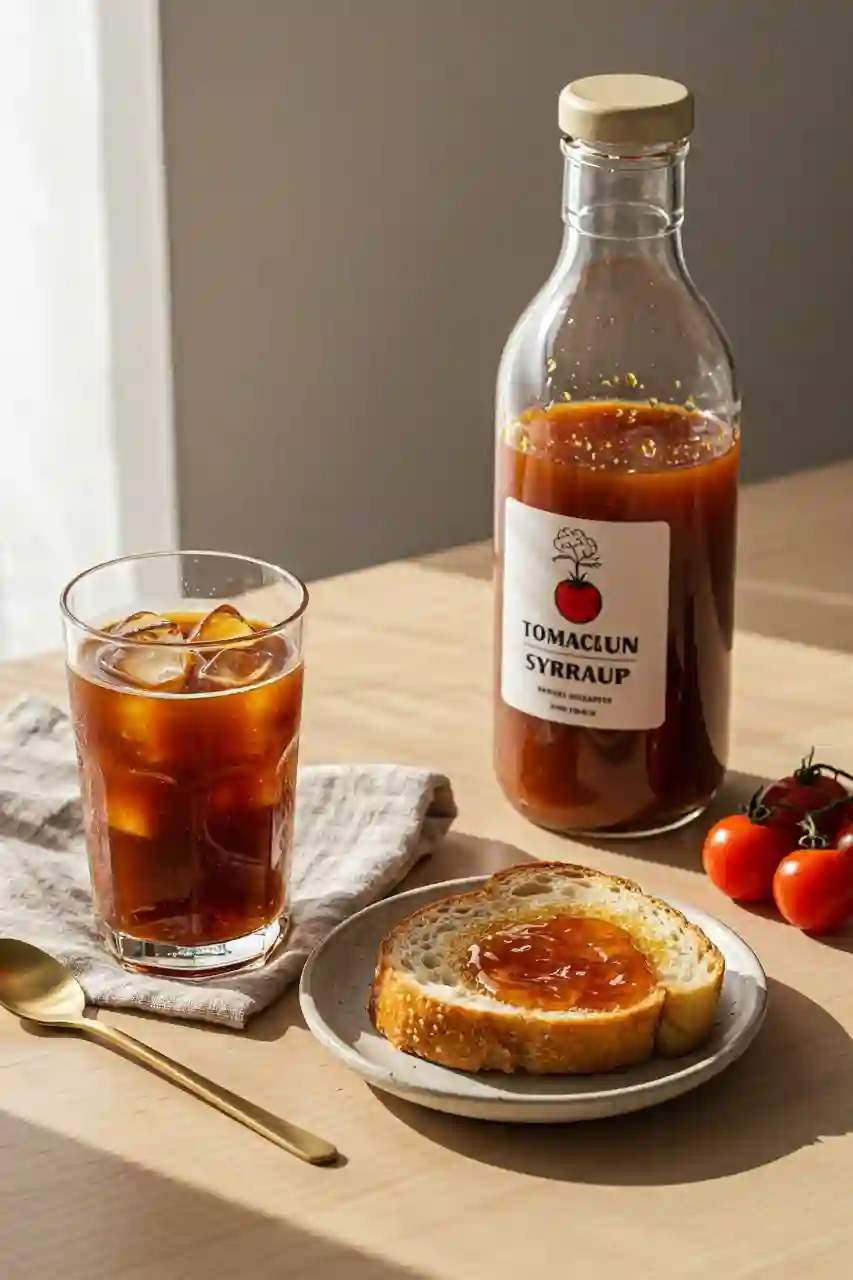
Storage & Shelf Life
Once strained and bottled, your tomato syrup should be stored in the refrigerator. The cool environment slows fermentation and preserves flavor.
How to Store the Korean Tomato Syrup:
- Use a clean, airtight glass bottle or jar
- Label with the date you strained it
- Keep it chilled at all times do not leave at room temperature
How Long Does It Last?
- Refrigerated: 2 to 3 weeks
- Frozen: Up to 3 months (use ice cube trays for portioning)
If the syrup smells sour, appears cloudy, or shows any signs of mold, discard it immediately.
Tip for Longer Shelf Life:
Add a splash of lemon juice or a pinch of citric acid to lower the pH and improve preservation.
FAQs About Korean Tomato Syrup Recipe
How to make tomato syrup?
To make tomato syrup, layer ripe, halved cherry tomatoes with sugar in a clean jar. Let it sit at room temperature for 2 to 3 days, stirring daily. Once the sugar has fully dissolved into the juice, strain the syrup and store it in the refrigerator.
What is Korean syrup called?
In Korean cuisine, syrup made from preserved fruits is called cheong. Traditional cheong is made by letting fruit and sugar sit together for days, allowing a syrupy liquid to form that’s perfect in drinks, desserts, or as a glaze.
What is a substitute for Korean syrup?
If you don’t have Korean cheong, you can use honey, maple syrup, or simple syrup as a substitute. However, they won’t offer the same fruit-forward flavor or fermented depth found in traditional cheong recipes.
What is Korean syrup used for?
Korean syrup (cheong) is often stirred into teas, coffee, sparkling water, or cocktails. It’s also used as a glaze for roasted meats, a topping for desserts, or even mixed into salad dressings and marinades.



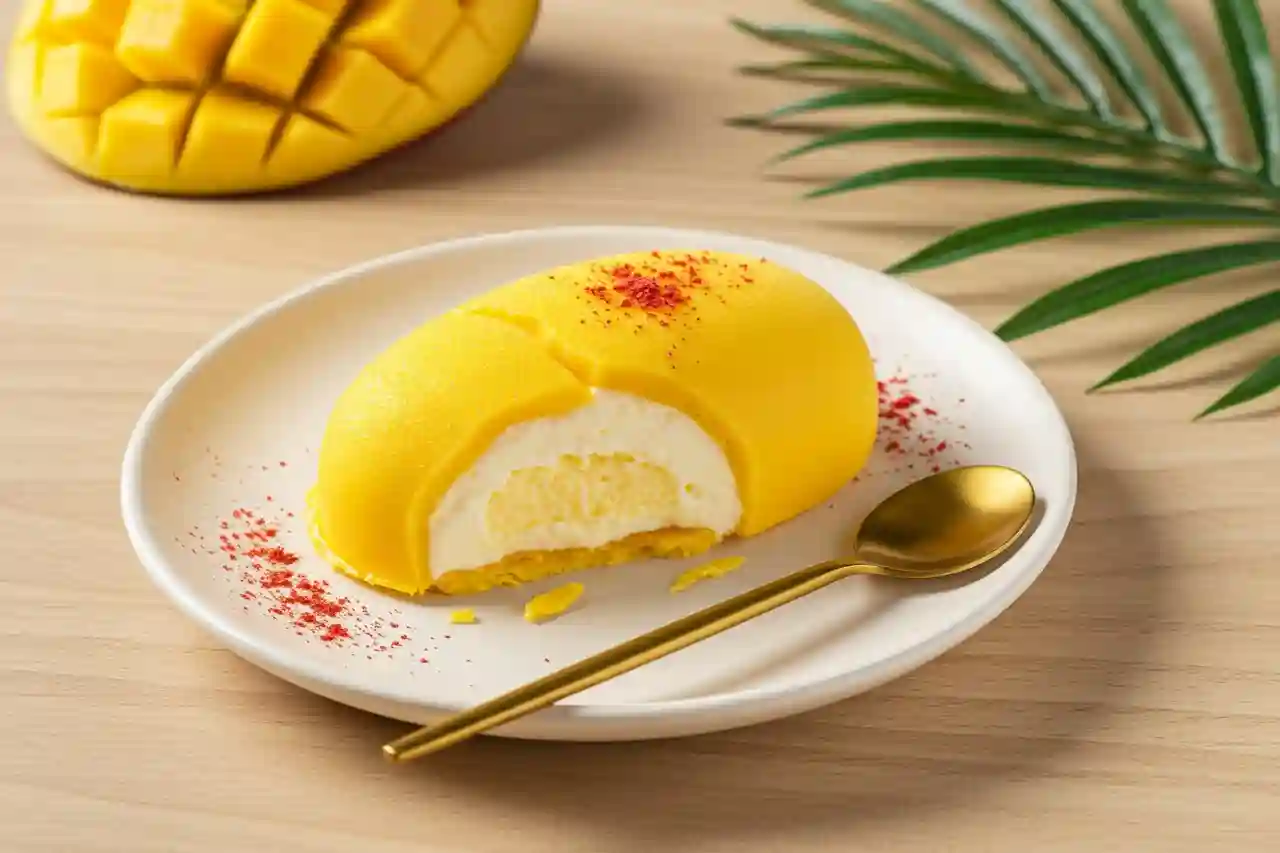







Yummy, I love this recipe!